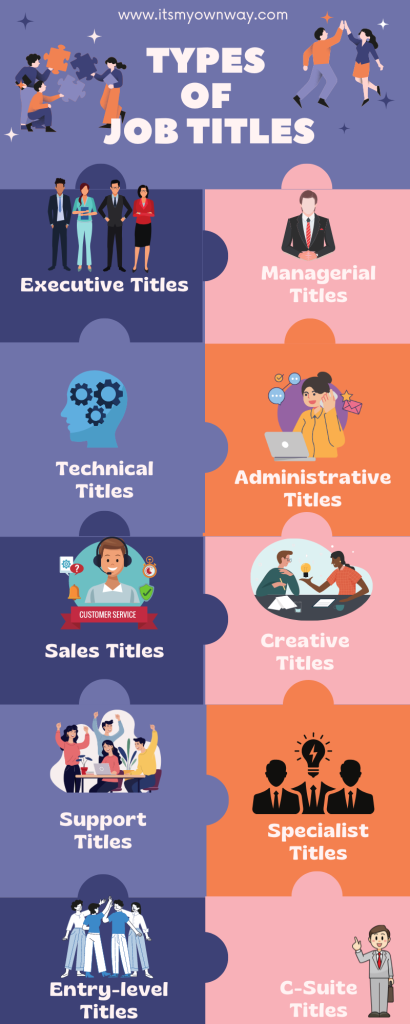Your job position is as important as that of the person’s title you are reporting to at work. For instance, a project manager who reports to a company president sounds more impressive than reporting to a department director. This is an add-on value for prospective employees. In this article, we will explain “What does Reporting to a Job Title Mean?“.
When you apply for a job at a new place, the application form usually asks you for the name of the organization, company, or business you were last employed with. They may also ask the question about the duration of time you indicate you worked for another employer wherein you need to enter the specific dates of starting employment and termination of employment with the previous employer. However, if you worked on your own, then you can simply enter “Self Employed” as the answer, in which case you wouldn’t be asked to specify who you reported to in the earlier employment.
Job Title Definition-
Ah, job titles—a collection of words that define our professional existence. They hold the power to make you feel like a superhero, or sometimes, a total imposter. But hey, titles are important, right? They give us a sense of identity and put us neatly into those little boxes society loves so much. So, let’s dive into the intriguing world of job titles and explore what they’re all about.
What are the different employment statuses?

By definition, employment is an activity or service which is performed for another. This service is performed in lieu of compensation or as an occupation. Employment is also defined as the act of employing or the state of being employed.
There are different types of employment statuses, such as:
Regular or Permanent Employment–
An employee is considered to be regularly or permanently employed when the employee performs activities that are normally needed or expected in conventional trade and business of the employer.
Term or Fixed Employment–
This type of employment requires the employee to work for the company or organization for a specific time period – for instance, 6 months, a year, or more. The employer has the right to extend the employment duration at their discretion, before or at the time of termination of the employee contract.
Project Employment–
Project employment is almost similar to fixed employment with the difference being that in the former, the employee is hired for working on a specific project. Under this type of employment, the employee is expected to work for the company or organization until the specific project is successfully completed.
Seasonal Employment–
Season employment is a form of temporary employment. Under this type of employment, the employee is hired to work for a company that offers seasonal services or products, such as at tourist places.
Casual Employment–
Casual employment is temporary. The employee is hired by the company or organization for a significantly short period of time or is not officially on the company’s payroll. Casual employment usually does not pay high wages and is almost always temporary employment positions.
Job Order–
This is another type of temporary employment and is usually meant to hire third-party service providers, such as hospitality and maintenance teams and technicians. Under this, the workers are hired for specific work or for intermittent jobs that last for significantly short durations, usually for less than 6 months, and get paid daily or hourly wages.
Types of Job Titles-
| Job Title Type | Explanation |
|---|---|
| Executive Titles | In an organization, high-level managers are given executive titles. These managers are responsible for making decisions and overseeing the company's overall operations. Some examples of executive titles are CEO (Chief Executive Officer) and CFO (Chief Financial Officer). |
| Managerial Titles | Individuals who are responsible for managing specific departments or teams are given managerial titles. These individuals handle the day-to-day running of their departments, manage staff and other resources, and work to achieve the overall goals of the organization. Examples of such titles include project manager, marketing manager, and HR manager. |
| Technical Titles | Professionals who are skilled in specific areas such as technology, engineering, or IT are given technical titles. They mostly work on technical tasks and may have job titles like software engineer, network administrator, or data scientist. |
| Administrative Titles | Individuals who are responsible for managing administrative tasks and office operations are assigned administrative titles. These titles such as administrative assistant, office manager, or secretary, help ensure that day-to-day office routines run smoothly. |
| Sales Titles | Sales titles are specifically assigned to professionals engaged in the sale of products or services. These titles mainly focus on two key aspects: generating revenue and cultivating strong relationships with clients. Some common examples of sales titles include sales representative, account executive, and business development manager. |
| Creative Titles | People working in fields that require creative skills, such as writing, design, or content creation, are given titles that reflect their creativity and talent. Some examples of these titles are graphic designer, content writer, or art director. |
| Support Titles | Individuals who provide assistance and support to customers or internal staff are given support titles. These individuals are responsible for resolving inquiries and problems. They may hold job titles such as customer support specialist or IT support technician. |
| Specialist Titles | Specialized titles are bestowed upon professionals who possess extensive knowledge in a specific field. These experts provide dedicated services or guidance within their area of expertise. Examples of such titles include financial analyst, marketing specialist, and legal consultant. |
| Entry-level Titles | Entry-level positions are intended for individuals who are new to the workforce or a specific field. These positions do not require a lot of experience and may have titles such as intern, trainee, or junior assistant. |
| C-Suite Titles | Top-level executives with "C" in their job titles are known as C-suite titles and are responsible for making important strategic decisions. Some examples of these titles are Chief Operating Officer (COO) and Chief Technology Officer (CTO). |
Source: thebalancecareers.com
Why is a job Title important?
Job titles are extremely important in a corporate structure. It is an essential part of the application process too. Using the correct information, applicants can decide whether the particular job position incompatible and suited to their skills. A job title is also helpful in determining whether this is the job you want to do.
From the employer’s perspective, a job title is crucial in ensuring that the applications being received for the specified position match the requirements of the said job title. A job title is also important for HR departments and third-party recruitment agencies to organize the selection process. It also helps those responsible for hiring to receive a higher number of relevant candidates who prove suitable for interviews and selection in the organization.
A job title is important because it helps streamline the selection process in a company. Some of the major benefits of using job titles in organizations are:
- It provides employees with the expectations and requirements for the job.
- It gives sufficient details that help candidates to assess whether they qualify for the specified position.
- It supports the recruitment team during the interview and final selection rounds.
- It helps develop an effective interview process.
- It helps to set goals and targets for the employee on joining.
Here’s information on what is included in a job title, and how you can use a job title in your job search. Also, see lists of job titles and job descriptions organized by industry and level of experience.
How Employees and Job Seekers Use Job Titles-

When you’re job hunting, you can search using your current job title or the title of the jobs you’re interested in as keywords.
Keywords for Job Searching:
Using keywords to job search will help refine your search to quickly find jobs that are a match. You can use job titles to narrow down jobs you’re interested in based on responsibilities and/or job level.
Use variations of the job title you’re interested in to see a broad selection of open positions.
Most job sites have advanced search options you can use to drill down and expedite your job search.
Job Titles on a Resume:
It is also important to use appropriate job titles on your resume. This gives the person reviewing your application a quick overview of your previous employment, so be as specific as possible. Do be sure what you list on your resume matches your LinkedIn profile, and lines up with what your previous employers will say when your references are checked.
Research Jobs:
For employees, lists of job titles will enable you to discover what other types of jobs you could be doing both at your organization and at other employers. They show you positions you can aspire to as you move up the career ladder, as well as jobs you can qualify for if you’re seeking a career change.
Frequently Asked Questions
What do reports mean in a job description?
The words “reports to” in a job description refer to the person or position that the employee in that role will directly answer to. This establishes the chain of command and makes the organization’s hierarchical structure clear.
What does it mean to “report to work”?
To “report to work” is to show up at the job site and start working at the appointed hour. It is crucial to maintain punctuality and carry out your professional duties.
What’s the difference between a job title and a job position?
Although they are frequently used synonymously, a job title and a job position have a slight distinction. A job position refers to the precise instance of that role being filled by a person, whereas a job title refers to the formal term given to a certain post inside an organisation.
How do I choose my job title?
The job title you choose will depend on a number of things. If you’re a business owner or independent contractor, you have more freedom to choose a title that accurately describes your area of expertise and the services you provide. In a corporate environment, your function, responsibilities, and the organization’s system for classifying jobs all play a part in determining your job title. It’s crucial to pick a title that truly describes your abilities and is consistent with your professional objectives.
Conclusion
Reporting to a job title is defined as the person up the corporate hierarchy that you report to when in a job position. The higher the person you report to on the corporate ladder, the more impressive it sounds on your resume and next job application.
Read More: A Rewarding Career: The Best Jobs That Help People











